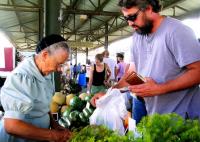Food shelves innovate to get wholesome food directly from farms
 Some food shelves are going direct to the source for healthier donations. CC photo: kansasexplorer
Some food shelves are going direct to the source for healthier donations. CC photo: kansasexplorer
An innovative organization called Farm to Family is helping 44 of California’s food shelves find a new source for food with a dual goal of acquiring more wholesome donations.
Food shelf demand is soaring across the country but food banks are suffering along with everyone else from the bad economy. At the same time, more efficient handling of food stock by supermarkets means they have fewer leftovers to donate.
"Supermarkets are much better able to track and predict what will sell, thanks to innovations such as customer club cards,” Sue Sigler, executive director of the California Association of Food Banks, told the L.A. Times. “So they have fewer leftovers. At the same time, secondary markets overseas and dollar stores are taking many of the products that might have gone to food banks."
Steve Sharp, a Farm to Family food solicitor, is doing something to address the shortfall while getting more healthful food on the tables of Californians who use food shelves. He’s going directly to the growers, such as corn grower Rudy Schaffner who has a farm in Holtville, a small town in the Imperial Valley in central California.
Schaffner once thought the short cobs of corn or ones with missing kernels on the cob, but otherwise perfectly edible, were rejects destined for the compost heap or for animal feed.
That was yesterday. Today Sharp along with two other Farm to Family solicitors, troll the state looking for farmers who are willing to donate their leftovers to food banks, or sell it at a deep discount.
All of this is part of the effort to get more wholesome, healthful food to the banks, and coincides with "a sea shift in food banking, due to recommendations about proper nutrition, the link between food insecurity and obesity," commented Sigler.
"The common wisdom in food banks for many years was that we need to give people adequate calories," she said. "Now we know that we also need to give people healthy food."
Because of all these things food banks are becoming more assertive and more selective shoppers. The California Association of Food Banks has set a goal to procure 87 million pounds of seasonal produce a year through the Farm to Family network. Some of the produce will be donated and some will be purchased for pennies on the dollar to supply California’s 44 food banks, said Ron Clark, the association's food sourcing and logistics manager.
Teaming up with the food banks works to the farmers’ advantage, too.
Frequently they have a bumper crop they can’t afford to store, or their deliveries get backed up due to adverse weather conditions, leaving them stuck with truckloads of produce that will rot if they don’t find a way to get it to someone who wants it.
Farm to Family helps them cut their losses.
The idea is catching on and Sharp doesn’t always have to go treasure hunting. Now growers are starting to call him about their excess produce.
One of the regulars that Sharp visits is Jack Vessey, a fourth-generation farmer who grows cabbage and other green vegetables on a 10,000-acre spread just north of the Mexican border.
Vessey has donated food to the bank in nearby El Centro, but said his new arrangement is different. He said Sharp is a customer, “albeit one who pays a deeply discounted price.”It's a win-win situation,” he said.
There are several Farm to Family networks operating throughout the country. With some the focus is on building an organic farming network and buying club, for others it’s promoting sustainable agriculture or getting wholesome food into food shelves. The common goal of all the efforts is building bridges between consumers and food producers. For more information visit, farmtofamilyonline, farmtofamily.net, or farmtofamily.com.



 del.icio.us
del.icio.us Digg
Digg












This is a lovely story that shows what an ordinary person can accomplish in helping everyone win!
This would be good for all of us.I must say this step will decrease number of problems.Thanks for sharing such a great useful news.
Post your comment